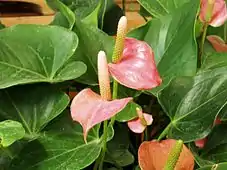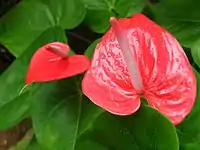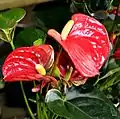Anthurium andraeanum
Anthurium andraeanum is a flowering plant species in the family Araceae that is native to Colombia and Ecuador.[1] A winner of the Royal Horticultural Society's Award of Garden Merit,[2] it is one of the plants listed in the NASA Clean Air Study[3][4] as effective in removing formaldehyde, xylene, toluene, and ammonia from the air.
| Anthurium andraeanum | |
|---|---|
 | |
| Flower of A. andraeanum | |
| Scientific classification | |
| Kingdom: | Plantae |
| Clade: | Tracheophytes |
| Clade: | Angiosperms |
| Clade: | Monocots |
| Order: | Alismatales |
| Family: | Araceae |
| Genus: | Anthurium |
| Species: | A. andraeanum |
| Binomial name | |
| Anthurium andraeanum | |
| Synonyms[1] | |
|
Anthurium venustum Sodiro | |
Names
Common names for plants in the genus Anthurium include flamingo flower, tailflower, painter's palette, and laceleaf.[5][6][7][8] Its name comes from the Greek words anthos, meaning flower, and oura, meaning a tail, referring to the spadix.[9]
Description
_1200.jpg.webp)
It is a monocotyledonous perennial, preferring warm, shady and humid climates, such as tropical rainforests. Its most characteristic feature as an ornamental is its brightly colored spathe leaf, and the protruding inflorescence called the spadix.[10]
It is a short erected plant with whole, cardioid or heart-shaped leaves, generally reflexed, cordate base, apex acuminate or cuspid, which are borne by a cylindrical petiole 30–40 cm long.
The spathe is cartilage-waxy, brightly coloured (red, pink) and 8–15 cm long, excluding the inflorescence (the spadix), which is 7–9 cm long, similar to a candle-holder, white or yellow in colour, is erected, and bears many small hermaphroditic flowers. These include a perianth with four segments and stamens with a compressed mesh. Flowering extends throughout the year.[7]
Distribution
Native to Ecuador and southwestern Colombia, it is also naturalised in other parts of the world. It is found in the Caribbean and Réunion. It is grown as an ornamental plant in the form of many hybrids or horticultural varieties. It is commonly used to make bouquets.
Toxicity
The whole plant is toxic. It contains saponins and crystals of calcium oxalate, in fine needles, able to penetrate the mucous membranes and provokes painful irritations. It is toxic to all mammals: a mouth-worn fragment can cause severe irritation of the mouth and throat. Contact with a human causes erythema, blisters, and if ingested, salivation, difficulty in swallowing and vomiting.[12]
Gallery
_1200.jpg.webp) Anthurium andraeanum
Anthurium andraeanum Anthurium andraeanum cultivar
Anthurium andraeanum cultivar Anthurium andraeanum cultivar
Anthurium andraeanum cultivar Anthurium andraeanum cultivar
Anthurium andraeanum cultivar Flamingo lilies
Flamingo lilies Anthurium andraeanum cv. Previa
Anthurium andraeanum cv. Previa
See also
References
- Kew World Checklist of Selected Plant Families
- "RHS Plantfinder – Anthurium andraeanum". Royal Horticultural Society. Retrieved 12 January 2018.
- Plants "Clean" Air Inside Our Homes (kilde NASA)
- B. C. Wolverton; Rebecca C. McDonald; E. A. Watkins, Jr. "Foliage Plants for Removing Indoor Air Pollutants from Energy-efficient Homes" (PDF). Retrieved 2009-12-10., "Archived copy" (PDF). Archived from the original (PDF) on 2011-10-05. Retrieved 2012-11-19.CS1 maint: archived copy as title (link) (alternate link for 'Foliage Plants for Removing Indoor Air Pollutants from Energy-efficient Homes')
- Anthurium spp. Archived 2013-10-03 at the Wayback Machine Poisonous Plants of North Carolina. North Carolina State University.
- Anthurium. ITIS.
- Govaerts, R. & Frodin, D.G. (2002). World Checklist and Bibliography of Araceae (and Acoraceae): 1–560. The Board of Trustees of the Royal Botanic Gardens, Kew.
- Nadruz Coelho, M.A., Waechter, J.L. & Mayo, S.J. (2009). Revisão taxonômica das espécies de Anthurium (Araceae) seção Urospadix subseção Flavescentiviridia. Rodriguésia; Revista do Instituto de Biologia Vegetal, Jardim Botânico e Estaçao Biologica do Itatiaya 60: 799–864.
- "Anthurium Andraeanum." Missouri Botanical Garden
- Collette VE, Jameson PE, Schwinn KE, Umaharan P, Davies KM (2004) Temporal and spatial expression of flavonoid biosynthetic genes in flowers of Anthurium andraeanum. Physiol Plant 122:297–304. doi:10.1111/j.1399-3054.2004.00402.x
- Linden ex André, Ill. Hort. 24: 43 (1877).
- Jacques Fournet, Flora illustrated the flowering of Guadeloupe and Martinique , Gondwana editions, CIRAD2002 Volume 1 ( ISBN 2-87614-489-1 ) ; Volume 2 ( ISBN 2-87614-492-1 )
